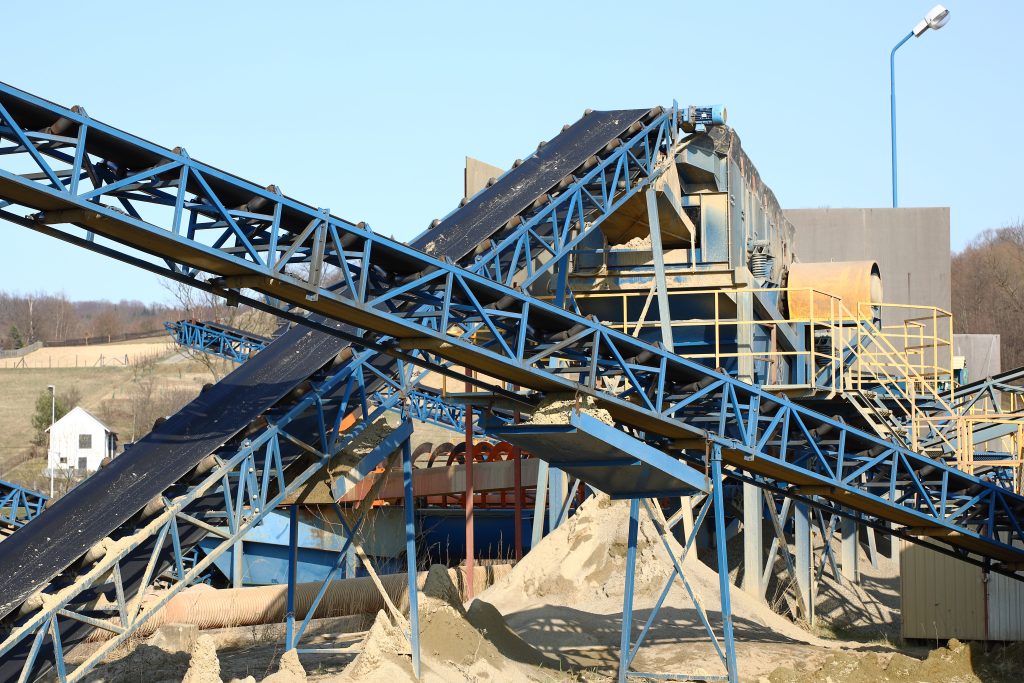Things to Consider When Selecting a Heavy Construction Conveyor

The approach taken to transporting bulk material has a significant impact on the cost and profitability of a construction project. It can even influence the chances of winning future business, especially when the client is a state or municipal body.
Construction companies typically start out planning to use trucks for material transport. For many projects, especially larger projects of a longer duration, a construction conveyor may be the better choice. This article explains why that’s the case and offers advice on selecting a heavy construction conveyor.
REASONS FOR PREFERRING A CONSTRUCTION CONVEYOR
An earth-moving construction conveyor provides continuous transport of bulk material, rock, and construction aggregate between two points. Those points need not be permanently fixed though. When specified and designed appropriately, a conveyor can be extended or shortened as needed. Adding a stacker conveyor, or even a telescoping, radial stacker conveyor, increases material deposition flexibility.
Compared to trucks, a construction conveyor:
- Reduces the number of trucks and truck drivers needed – of even greater importance when it’s difficult to recruit drivers.
- Avoids the need to haul over roads, thus reducing congestion and the risk of accidents.
- Reduces dust levels, spills, noise, and emissions which prevents complaints from neighbors and satisfies nuisance requirements.
Taken together, these can result in significant cost savings. When future business is taken into consideration, it can lead to growth and increased profitability.
CONSIDERATIONS WHEN SELECTING A HEAVY CONSTRUCTION CONVEYOR
Getting exactly the right conveyor for the project or application requires addressing many aspects of design and construction. However, the main points to consider at the outset are:
- Quantity of material to be moved
- Material characteristics
- Distance and route
- Restrictions
- Environment
- Timeline
QUANTITY OF MATERIAL
This may be known or expressed in terms of volume or weight. Applying the material loose bulk density yields the number of truckloads needed or alternatively, the rate at which the conveyor needs to move the bulk material.
MATERIAL CHARACTERISTICS
Loose bulk density is a critical value, but it’s also important to know repose angle, particle size, moisture content, and abrasiveness. Together, these tell the conveyor engineering company what they must design for. Factors like height of belt troughing, conveyor cover material, belt scraping, and the degree of dust protection needed all depend on these values.
Conveyor industry construction guides provide some information on the properties of individual materials. However, as site conditions can vary widely, it’s always advisable to either have the material tested or provide the conveyor company with a representative sample.
DISTANCE AND ROUTE
This determines the total weight the conveyor will transport, and hence the power and torque needed from the drive. Elevation changes have a significant impact and these should be included in the requirements specification.
Road or rail crossings should also be identified as minimum height restrictions apply. Water crossings are a particular concern due to the risk of material spills causing contamination, especially when moving potentially toxic materials. Minimum heights apply here, too.
RESTRICTIONS
Regulatory bodies often impose limitations on construction site hours, and sometimes also noise and dust emissions. This is where a construction conveyor offers significant advantages over front-end loaders or haul trucks. As the conveyor results in less nuisance, it may simplify and speed up the project approval process and can even allow longer operating hours.
ENVIRONMENT
Wind, rain, temperatures, and dust all factor into the conveyor design. In addition, and as highlighted previously, urban areas pose particular challenges. All these factors must be included in the list of requirements shared with the conveyor engineering company.
TIMELINE
Project duration and timeline influence the tons per hour of conveyor capacity needed, but can also have financial implications. Construction vehicles like front-end loaders are often leased while a construction conveyor is typically purchased but can be leased from some companies. Consequently, financial factors tend to favor conveyors for larger, multi-year projects.
DISCUSS YOUR PROJECT WITH A CONVEYOR SPECIALIST
For many larger and longer-duration construction projects, a conveyor offers many advantages over trucks for moving bulk material. These include cost savings, improved safety, and reduced nuisance/environmental impact. The last of these is especially important in projects in urban or suburban areas where noise and dust can be significant concerns.
Selecting a heavy construction conveyor involves considering a host of project and environmental factors as well as the volume, weight, and characteristics of the material to be transported. Careful evaluation of all of these will lead to the most cost-effective solution for your needs. Check out our Heavy Construction Conveyor Engineering Guide for details.
West River Conveyors has deep expertise in conveyor design and construction, accumulated over more than three decades in the industry. We focus on engineering robust, reliable systems that meet the needs of our clients. Our specialists can help you determine if a construction conveyor is appropriate for your project.

